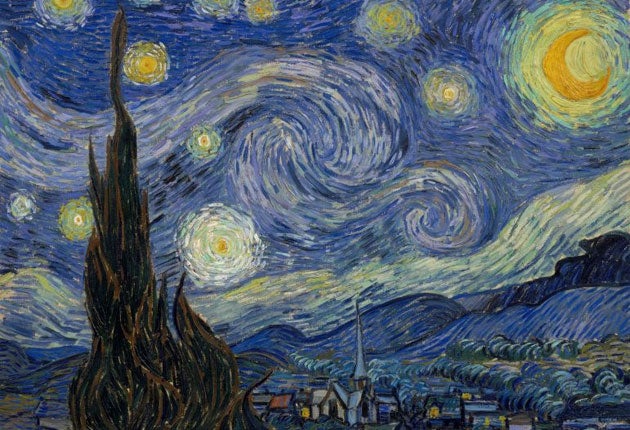Van Gogh and the Colours of the Night, Van Gogh Museum, Amsterdam
Folklore turned Van Gogh into a tortured loon, but the truth is in his work, and fantasies are pointless

Your support helps us to tell the story
From reproductive rights to climate change to Big Tech, The Independent is on the ground when the story is developing. Whether it's investigating the financials of Elon Musk's pro-Trump PAC or producing our latest documentary, 'The A Word', which shines a light on the American women fighting for reproductive rights, we know how important it is to parse out the facts from the messaging.
At such a critical moment in US history, we need reporters on the ground. Your donation allows us to keep sending journalists to speak to both sides of the story.
The Independent is trusted by Americans across the entire political spectrum. And unlike many other quality news outlets, we choose not to lock Americans out of our reporting and analysis with paywalls. We believe quality journalism should be available to everyone, paid for by those who can afford it.
Your support makes all the difference.Has an artist ever been worse served by a musician than Vincent van Gogh by Don McLean? McLean's song "Vincent" set the seal on 70 years of error by portraying its subject as a tortured loon.
"Now I think I know what you tried to say to me,
How you suffered for your sanity,
How you tried to set them free.
They would not listen, they're not listening still.
Perhaps they never will ... "
This image of Van Gogh had taken early root in 1904 when the painter's German biographer, Julius Meier-Graefe, depicted him as a Dutch Young Werther. It spread, via Vincente Minnelli's film Lust for Life, to McLean and "Starry, Starry Night". Sadly, Van Gogh seems merely to have been an epileptic who suffered bouts of depression – reasonably, given the critical reception of his work in his lifetime. But the belief that his genius was a symptom of romantic madness stuck in the public mind.
So a show in Amsterdam called Van Gogh and the Colours of the Night plays a clever game. The appearance of MoMA's The Starry Night (1889) on the exhibition's posters will set the Van Gogh Museum's turnstiles a-whirr with backpackers humming McLean's emetic ditty under their breaths. You can almost hear the groans of disappointment at what they will find inside. Far from being a swivel-eyed Promethean who was raised by wolves and dashed off canvases between bouts of ear mutilation, Van Gogh is shown as a careful and studious painter, a theological scholar who read art history and theory in three languages.
For McLean fans, the biggest shock of all will be a picture painted in 1851 by Jean-François Millet, lent by Yale and bearing the ominously familiar title of La nuit étoilée (The Starry Night). That Van Gogh had artistic forebears at all is a nasty surprise; that these include Millet – and so literally to boot – verges on the unthinkable. And yet the Dutchman's taste not just for starry nights but for what he called les paysans chez eux (peasants at home) comes directly from his Barbizon forebear, as witness the museum's own horny-handed The Potato Eaters of 1885.
Broadly, the VGM's show uses Van Gogh's taste for the night to glue together his disparate parts as an artist. Long before there was Vincent the Painter of Stars, there was Vincent the Realist – a pastor's son who followed Millet and Courbet in painting scenes of rural hardship. Only four years separate his Potato Eaters and Starry Night, and yet they are worlds apart in brushwork, palette and interest.
There are various ways of tracing the path between the two works, the earlier often credited as Van Gogh's first masterpiece, the later as the apogee of his Saint-Rémy swirl paintings. You might see their maker's preoccupation as changing from actual to psychic inscape – a reversal called for, perhaps, by his incarceration in an asylum. You might equally detect Gauguin's Post-Impressionist hand in the artificiality of Van Gogh's later palette, a French rejection of The Potato Eaters' Rembrandty Dutchness.
Or, as this show does, you might choose to see both pictures as nocturnes, albeit of a wildly different kind. Certainly, Van Gogh had things to say about the night, and his views on the subject are stencilled on the museum's walls. Thus, "It often seems to me that the night is more richly coloured than the day," and "I have a terrible need for – I'll use the word – religion, so I go outside at night to paint the stars." The problem with seeing him as a painter of the night, though, is that he wasn't, or not really.
What I mean is this: both The Potato Eaters and The Starry Night were painted after dark, and both outside the studio. The question is whether either is a nocturne, which is to say a picture whose subject is the night. It seems clear that Van Gogh's real interest in the first work is to depict a biblical poverty for which the light of an oil lamp stands as a metaphor. In the same way, the aim of the second is to arouse a state of ecstasy by combining swirling forms, broken brush-strokes and a silvered palette. The night is merely a vehicle for these things, not their subject; the time of day is, to a large extent, coincidental. Van Gogh and the Colours of the Night does Vincent a great favour in de-McLeaning him. But it also tries to turn him into something he was not, which is less useful.
Van Gogh Museum, Amsterdam, to 7 June (vangoghmuseum.nl)
Join our commenting forum
Join thought-provoking conversations, follow other Independent readers and see their replies
Comments